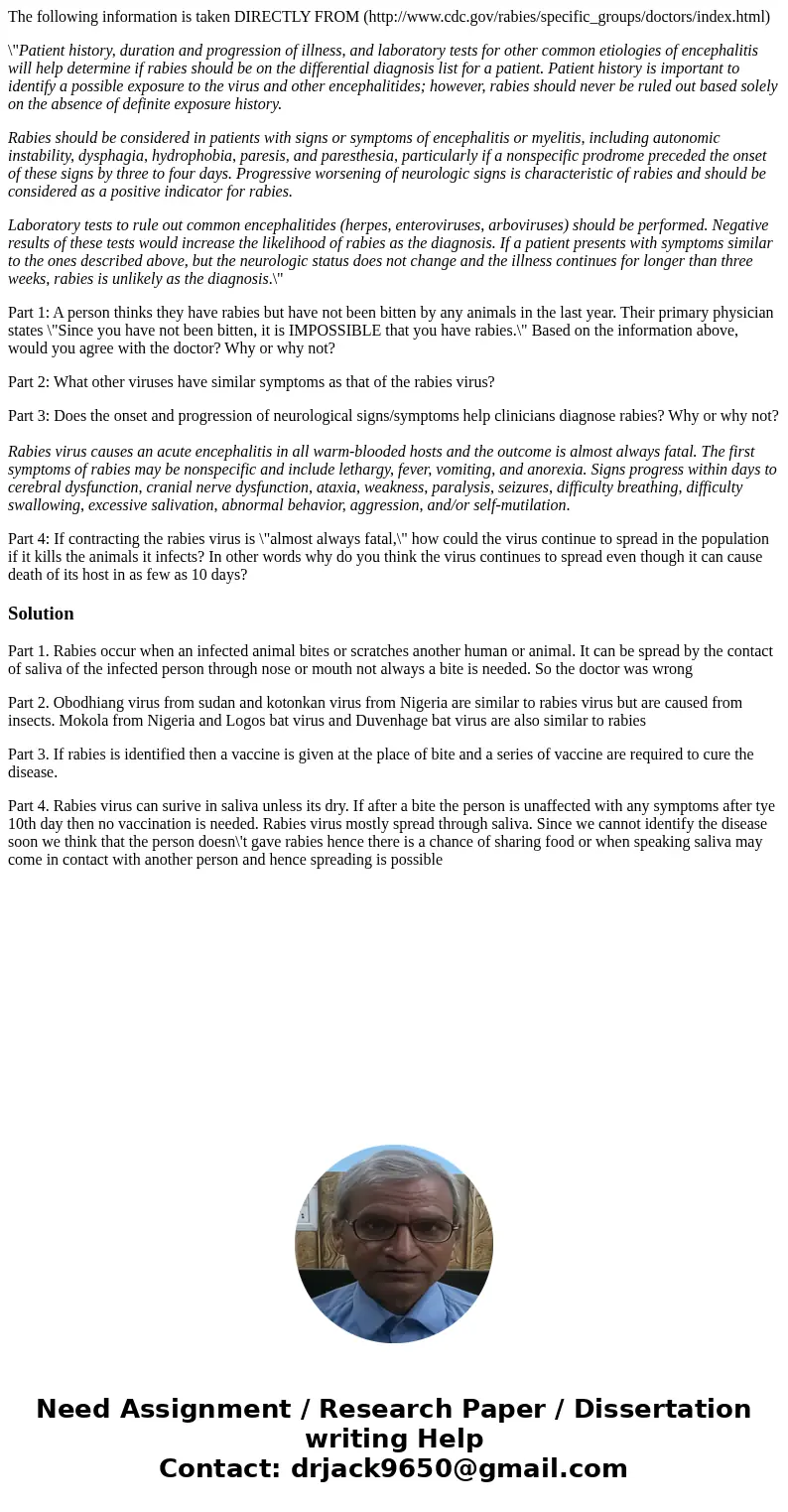The following information is taken DIRECTLY FROM httpwwwcdcg
The following information is taken DIRECTLY FROM (http://www.cdc.gov/rabies/specific_groups/doctors/index.html)
\"Patient history, duration and progression of illness, and laboratory tests for other common etiologies of encephalitis will help determine if rabies should be on the differential diagnosis list for a patient. Patient history is important to identify a possible exposure to the virus and other encephalitides; however, rabies should never be ruled out based solely on the absence of definite exposure history.
Rabies should be considered in patients with signs or symptoms of encephalitis or myelitis, including autonomic instability, dysphagia, hydrophobia, paresis, and paresthesia, particularly if a nonspecific prodrome preceded the onset of these signs by three to four days. Progressive worsening of neurologic signs is characteristic of rabies and should be considered as a positive indicator for rabies.
Laboratory tests to rule out common encephalitides (herpes, enteroviruses, arboviruses) should be performed. Negative results of these tests would increase the likelihood of rabies as the diagnosis. If a patient presents with symptoms similar to the ones described above, but the neurologic status does not change and the illness continues for longer than three weeks, rabies is unlikely as the diagnosis.\"
Part 1: A person thinks they have rabies but have not been bitten by any animals in the last year. Their primary physician states \"Since you have not been bitten, it is IMPOSSIBLE that you have rabies.\" Based on the information above, would you agree with the doctor? Why or why not?
Part 2: What other viruses have similar symptoms as that of the rabies virus?
Part 3: Does the onset and progression of neurological signs/symptoms help clinicians diagnose rabies? Why or why not?
Rabies virus causes an acute encephalitis in all warm-blooded hosts and the outcome is almost always fatal. The first symptoms of rabies may be nonspecific and include lethargy, fever, vomiting, and anorexia. Signs progress within days to cerebral dysfunction, cranial nerve dysfunction, ataxia, weakness, paralysis, seizures, difficulty breathing, difficulty swallowing, excessive salivation, abnormal behavior, aggression, and/or self-mutilation.
Part 4: If contracting the rabies virus is \"almost always fatal,\" how could the virus continue to spread in the population if it kills the animals it infects? In other words why do you think the virus continues to spread even though it can cause death of its host in as few as 10 days?
Solution
Part 1. Rabies occur when an infected animal bites or scratches another human or animal. It can be spread by the contact of saliva of the infected person through nose or mouth not always a bite is needed. So the doctor was wrong
Part 2. Obodhiang virus from sudan and kotonkan virus from Nigeria are similar to rabies virus but are caused from insects. Mokola from Nigeria and Logos bat virus and Duvenhage bat virus are also similar to rabies
Part 3. If rabies is identified then a vaccine is given at the place of bite and a series of vaccine are required to cure the disease.
Part 4. Rabies virus can surive in saliva unless its dry. If after a bite the person is unaffected with any symptoms after tye 10th day then no vaccination is needed. Rabies virus mostly spread through saliva. Since we cannot identify the disease soon we think that the person doesn\'t gave rabies hence there is a chance of sharing food or when speaking saliva may come in contact with another person and hence spreading is possible

 Homework Sourse
Homework Sourse